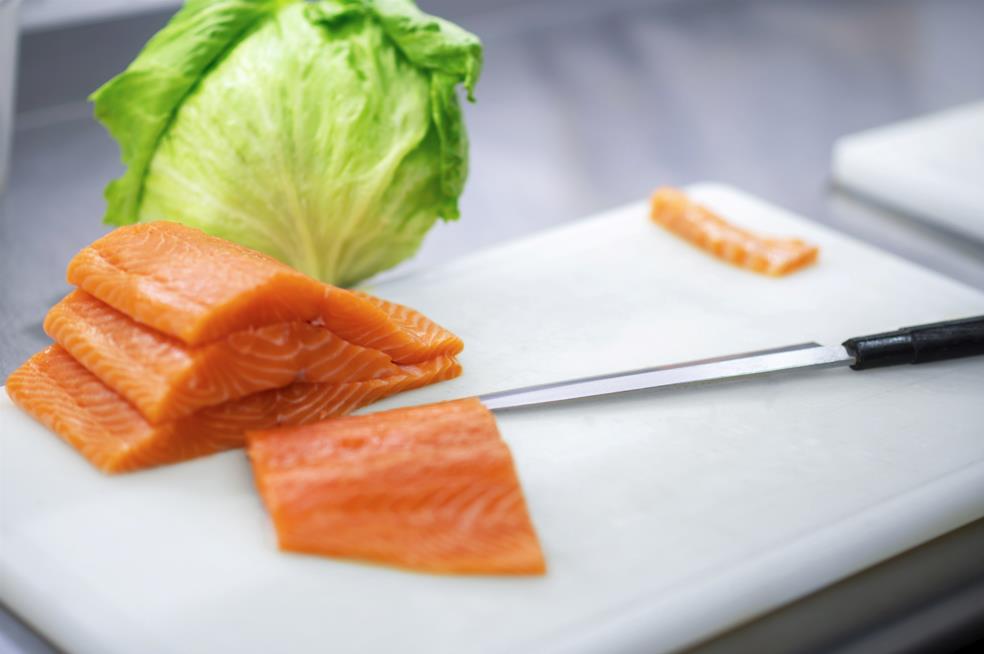Sujihiki is the Japanese slicing knife favored for its thin, narrow, long blade. This blade shape creates minimal friction when slicing boneless animal protein, giving tear-free cuts.
Ensuring the slices are intact is particularly important when cutting fish, but Sujihiki’s usefulness goes beyond just that. Sujihiki has the same blade profile as the Yanagiba, the sushi knife, but with a double bevel edge. This similarity to the Yanagiba and the bevel difference makes many chefs regard Sujihiki as the western equivalent of the Japanese knife.
These attributes make Sujihiki a versatile knife that can be utilized for many things. If you’re looking for a knife to carve, slice, fillet, trim, and do detailed work on fish and meat, Sujihiki will work wonders for you.
Table of contents
Sujihiki knife features
- Sujihiki has an extremely thin blade that glides through boneless meat easily. Even at the spine, the thickest part, it measures around 2mm wide. Compared to western knives, which are between 3.5 and 4.5mm thick, it’s remarkably slim.
- Despite the double bevel, Sujihiki’s edge is also exceptionally thin. In comparison, most double bevel kitchen knives, like western chef’s knives, have an edge that gets sharp snappily. Sujihiki is ground at a lower angle to have a rather long, thin, sharp edge. Since this also means it’s delicate at the same time, cutting dense ingredients should be avoided.
- Because Sujihiki is an all-rounder kitchen knife for cutting all types of meat, it has a double bevel edge. There are no single bevel alternatives to it. If it had a single bevel edge, it wouldn’t be a Sujihiki anymore. As the resemblance is identical, it would be Yanagiba. That’s why there are no single bevel Sujihiki knives.
- The blade design is pretty straightforward. It’s long and narrow, resembling a needle. The cutting edge is relatively flat throughout most of the blade and slightly curves to a pointy tip.
- Sujihiki has a variety of length options available from 8 to 12 inches. The proper way to cut with a Sujihiki is by making a single pulling motion towards yourself over the meat from the heel to the tip. Consider this when choosing the size.
- Generally weighing around 120 grams, Sujihiki is a lightweight kitchen knife. If a chef’s knife is all you use to make slices, picking up a Sujihiki will feel a lot lighter. The thin, light blade is also balanced forward, making slicing less tiresome.
Sujihiki’s best uses

Sujihiki’s primary use is on boneless animal protein. It’s also a viable option for filleting fish, but a different knife like the Yanagiba might be a better pick if you’re doing this more than you slice – more on that below.
The narrow blade makes it a great knife to carve beef and poultry. Sujihiki will stick less as the blade profile creates minimal friction and give you the best slices. Even on denser ingredients like some types of squash, wedging won’t be as much of an issue. It will slide right through. For anything you can cut without a bone or seed getting in the way, you can employ Sujihiki to produce fine slices.
The triangular end is also great for cleaning up a wide variety of meat, from sirloin to chicken breasts to large fish. Sujihiki can be used as both a slicing and carving knife, although it resembles a slicing knife more with its sharp tip.
Overall, Sujhiki is a great knife to turn to whenever you need to make precise slices and never disappoint. Nonetheless, there are some things you should avoid when using a Sujihiki.
Slicing technique
Sujihiki’s use is somewhat limited if you’re mostly rock chopping, as the shape of the blade won’t allow it. When you slice with Sujihiki, you’ll often find yourself cutting from the heel or the belly of the blade to the tip in a sweeping motion.
This kind of slicing method is known as pulling. You pull the place towards yourself as you slice. If you’re not used to this, you might take out a Sujihiki only when you need a knife to make precise slices of fish and meat, becoming less serviceable.
Any chef interested in Japanese cuisine should familiarize themselves with this technique. Japanese dishes often require thinly sliced ingredients, and this technique with a Japanese slicing knife is the easiest way to produce them.
Things to think again before using Sujihiki
For certain tasks, Sujihiki may be flimsy. Japanese knives are almost always thinner and harder than their western counterparts, so some duties make them susceptible to chipping. These mainly include cutting through bones or other dense ingredients and using force to cut.
For example, you can utilize a hammer to cut the head of a fish with a filleting knife. Sujihiki, on the other hand, may not endure the stress the same way from the spine to the edge. A traditional western filleting knife is flexible and can take a beating without worrying about the edge – Sujihiki, not so much.
Sujihiki vs. Yanagiba

Take a Sujihiki in one hand; Yanagiba in the other. You won’t feel much of a difference, and in fact, you probably won’t even notice any disparities at all. Before you tell yourself that both knives are the same, remember that small details sometimes make the biggest differences.
The primary difference between Sujihiki and Yanagiba is on the knife’s edge. Yanagiba is a single bevel knife, meaning the blade is only ground on one side to form the cutting edge. This works amazingly for filleting and slicing fish, as it’s thinner and sharper but more fragile.
Sujihiki has a double bevel edge, usually with a 50/50 grind. Some options have a bias on one side for better use in either right or left hand. Since Sujihiki isn’t only for cutting fish, the double bevel edge gives extra toughness while making the blade durable and easier to use. Single bevel kitchen knives have a specific cutting angle that you can’t go much outside of it. Learn more about single bevel edge kitchen knives.
While there are other differences, the main distinction is at the edge and use. Yanagiba is for filleting and thinly slicing fish. Not to say that Sujihiki can’t accomplish these, which it can obviously, but if a Japanese knife to slice fish is all you’re anticipating, Yanagiba is a better-suited option.
Sujihiki is more of an all-rounder slicing knife that’s also great on other boneless animal protein, not just fish. Read our detailed article on the differences between Sujihiki and Yanagiba.
Do you need a Sujihiki?
Sujihiki can be a viable option for slicing, deboning, and cleaning up animal protein, with fish being a priority. You can also choose Sujihiki over other Japanese knives to work with fish for its double bevel edge. The specialty knives like this with a double bevel edge are easier to operate, and the cutting angle doesn’t matter.
Surely, these sound great but keep in mind that Sujihiki is certainly not a primary knife. It’s a specialized slicing knife that gives perfect pieces on softer ingredients. Still, it can’t be the only knife you can use for everything. It’s best to pair Sujihiki with a chef’s knife to handle other duties like chopping vegetables and herbs.
If a slicer solely for boneless meat is what you need, Sujihiki is one of the best Japanese alternatives to thea western slicing knife.
Closing
Overall, Sujihiki is a Japanese kitchen knife you can use for multipurpose slicing. It’s the right slicing knife to go if fish is standard in your diet, but you also consume other animal protein. Read more on other Japanese kitchen knives on the HDMD Knives Blog and shop for handmade kitchen knives at our homepage.









